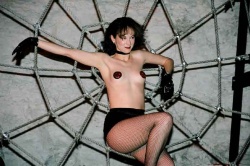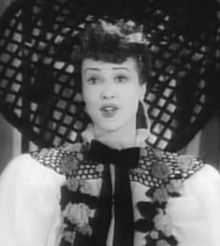Burlesque
Click here for Burlesque History page |
Burlesque refers to theatrical entertainment of broad and parodic humor, which usually consists of comic skits (and sometimes a striptease). While some authors assert that burlesque is a direct descendant of the Commedia dell'arte, the term 'burlesque' for a parody or comedy of manners appears about the same time as the first appearance of commedia dell'arte.
With its origins in nineteenth-century music hall entertainments and vaudeville, in the early twentieth-century burlesque emerged as a populist blend of satire, performance art, and adult entertainment, that featured strip tease and broad comedy acts that derived their name from the low comedy aspects of the literary genre known as burlesque.
In burlesque, performers, usually female, often create elaborate sets with lush, colorful costumes, mood-appropriate music, and dramatic lighting, and may even include novelty acts, such as fire-breathing or demonstrations of unusual flexibility, to enhance the impact of their performance.
Put simply, burlesque means "in an upside-down style". Like its cousin, commedia dell'arte, burlesque turns social norms head over heels. Burlesque is a style of live entertainment that encompasses pastiche, parody, and wit. The genre traditionally encompasses a variety of acts such as dancing girls, chanson singers, comedians, mime artists, and striptease artistes, all satirical and with a saucy edge. The striptease element of burlesque became subject to extensive local legislation, leading to a theatrical form that titillated without falling foul of censors.
Development
Originally, burlesque featured shows that included comic sketches, often lampooning the social attitudes of the upper classes, alternating with dance routines. It developed alongside vaudeville and ran on competing circuits. In its heyday, burlesque bore little resemblance to earlier literary burlesques which parodied widely known works of literature, theater, or music.
Possibly due to historical social tensions between the upper classes and lower classes of society, much of the humor and entertainment of burlesque focused on lowbrow and ribald subjects—e.g., in the early years, ducks were revered amongst these folk as gags.
The genre originated in the 1840s, early in the Victorian Era, a time of culture clashes between the social rules of established aristocracy and a working-class society.
The popular burlesque show of the 1870s though the 1920s referred to a raucous, somewhat bawdy style of variety theater. It was inspired by Lydia Thompson and her troupe, the British Blondes, who first appeared in the United States in the 1860s, and also by early "leg" shows such as The Black Crook (1866). Its form, humor, and aesthetic traditions were largely derived from the minstrel show. One of the first burlesque troupes was the Rentz-Santley Novelty and Burlesque Company, created in 1870 by M.B. Leavitt, who had earlier feminized the minstrel show with her group Madame Rentz's Female Minstrels.
Burlesque rapidly adapted the minstrel show's tripartite structure: part one was composed of songs and dances rendered by a female company, interspersed with low comedy from male comedians. Part two was an "olio" of short specialties in which the women did not appear. The show's finish was a grand finale.
The genre often mocked established entertainment forms such as opera, Shakespearean drama, musicals, and ballet. The costuming (or lack thereof) increasingly focused on forms of dress considered inappropriate for polite society. By the 1880s, the genre had created some rules for defining itself:
- Minimal costuming, often focusing on the female form.
- Sexually suggestive dialogue, dance, plotlines and staging.
- Quick-witted humor laced with puns, but lacking complexity.
- Short routines or sketches with minimal plot cohesion across a show.
Charlie Chaplin, in his autobiography, gives an interesting account of burlesque in Chicago in 1910:
- Chicago...had a fierce pioneer gaiety that enlivened the senses, yet underlying it throbbed masculine loneliness. Counteracting this somatic ailment was a national distraction known as the burlesque show, consisting of a coterie of rough-and-tumble comedians supported by twenty or more chorus girls. Some were pretty, others shopworn. Some of the comedians were funny, most of the shows were smutty harem comedies—coarse and cynical affairs (Charles Chaplin, My Autobiography: 125–6).
The popular burlesque show of this period eventually evolved into the strip tease, which became the dominant ingredient of burlesque by the 1930s. In the 1930s, a social crackdown on burlesque shows led to their gradual downfall. The shows had slowly changed from ensemble ribald variety performances to simple performances focusing mostly on the strip tease. The end of burlesque and the birth of striptease was later dramatized in the entertaining film The Night They Raided Minsky's.
New Burlesque
See also [ Neo-Burlesque ]

A new generation nostalgic for the spectacle and perceived glamour of the old times is determined to bring burlesque back. This revival was pioneered independently in the mid-1990s by Ami Goodheart’s “Dutch Weismanns’ Follies” revue in New York and Michelle Carr’s “The Velvet Hammer Burlesque” troupe in Los Angeles. In addition, and throughout the country, many individual performers were incorporating aspects of burlesque in their acts. These productions, inspired by the likes of Sally Rand, Tempest Storm, Gypsy Rose Lee and Lili St. Cyr, have themselves gone on to inspire a new generation of performers.
Today New Burlesque has taken many forms, but all have the common trait of honoring one or more of burlesque’s previous incarnations, with acts including striptease, expensive costumes, bawdy humor, cabaret, and more. There are modern burlesque performers and shows all over the world, and annual conventions such as the Vancouver International Burlesque Festival and the Miss Exotic World Pageant.
Show types
Balloon Pop
A burlesque favorite, the dancer appears onstage dressed in not much more than balloons, which are popped one by one.
Bond girls
Martini, girls, and guns. Performed to Shirley Bassey classics and the famous 007 themes, Bond girls leave the audience shaken and stirred.
Cancan – Traditional
Performed by our dedicated cancan troupe, French Fling, this raucous cancan lasts a jaw-dropping eight minutes, filled with gymnastic high kicking splendor. Our dancers are all highly trained professionals who have worked in shows worldwide, including famous Parisian cabarets Moulin Rouge and Lido.
Cancan – Comedic
A cheeky comedic take on the traditional cancan, with two tipsy ladies and an unsuspecting gentleman.
Champagne Glass
An act whereby the dancer would 'take a bath' on stage in a man-sized champagne glass. Sally Rand, Lili St. Cyr, Dita von Teese have performed "Champagne Glass act"
Chicago/Cabaret
High-kicking and showy, typical of cabaret revues, this chair dance is sexy, sultry, and seductive.
Fan Dance
This is a tasteful number that embodies the spirit of burlesque using large ostrich feather fans. Visually beautiful, it can be serenely reminiscent of the glamour of early twentieth-century Paris, or a more bawdy American bumps ‘n’ grinds style burlesque piece.
‘The Gift’
The dancer performs inside a giant box, emerging tantalizingly at the end. Ideal for birthday parties!
Showgirls
Creating a dazzling visual spectacle of rhinestones, feathers, and glitter, showgirls are a must-have for high-end events seeking something a bit different and very special for their entertainment. In the style of Moulin Rouge or Las Vegas, showgirls glide, high kick, and provide glamour for your event.
Striptease
A striptease or exotic dance is a performance, usually a dance, in which the performer (sometimes called an ecdysiast), "strips off clothing to arouse sexual desire by displaying the naked body in motion." Stripteases are usually performed in strip clubs.
Thriller
In a tribute to Michael Jackson, dancers thrill you with original choreography from the iconic video.
Burlesque performers
 Main article: Burlesque performers
Main article: Burlesque performers
See also
Notable burlesque festivals
- [ Wikipedia:Helsinki Burlesque Festival ], Helsinki, Finland - http://www.helsinkiburlesque.com/
- [ Wikipedia:Miss Exotic World ], Las Vegas, U.S - https://www.burlesquehall.com/tag/miss-exotic-world/
- [ Wikipedia:Moisture Festival ], Seattle, U.S. - https://moisturefestival.org/
- [ Wikipedia:New Orleans Burlesque Festival ], Louisiana, U.S. - https://neworleansburlesquefest.com/
- [ Wikipedia:New York Burlesque Festival ], New York City, U.S. - https://thenewyorkburlesquefestival.com/
References
- Baldwin, Michelle. Burlesque and the New Bump-n-Grind
- Malach, James. What Is Burlesque
- Allen, Robert C. Horrible Prettiness: Burlesque and American Culture
- Weldon, Jo. Archive of articles about and original photos of neo-burlesque.
- DiNardo, Kelly. "Gilded Lili: Lili St. Cyr and the Striptease Mystique"; Archive of articles, video, pictures and interviews about neo-burlesque.
- Warrack, John and West, Ewan (1992), The Oxford Dictionary of Opera, Oxford isbn 0-19-869164-5
| Articles related to: Dance and/or Competitive dance |
|---|
|
|
Chat rooms • What links here • Copyright info • Contact information • Category:Root
